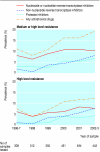Time trends in primary resistance to HIV drugs in the United Kingdom: multicentre observational study
- PMID: 16299012
- PMCID: PMC1309643
- DOI: 10.1136/bmj.38665.534595.55
Time trends in primary resistance to HIV drugs in the United Kingdom: multicentre observational study
Abstract
Objective: To examine whether the level of primary resistance to HIV drugs is increasing in the United Kingdom.
Design: Multicentre observational study.
Setting: All virology laboratories in the United Kingdom carrying out tests for HIV resistance as part of routine clinical care.
Participants: 2357 people infected with HIV who were tested for resistance before receiving antiretroviral therapy.
Main outcome measure: Prevalence of drug resistance on basis of the Stanford genotypic interpretation system.
Results: Over the study period (February 1996 to May 2003), 335 (14.2%, 95% confidence interval 12.8% to 15.7%) samples had mutations that conferred resistance to one or more antiretroviral drugs (9.3% high level resistance, 5.9% medium level resistance). The prevalence of primary resistance has increased markedly over time, although patterns are specific to drug class; the largest increase was for non-nucleoside reverse transcriptase inhibitors. In 2002-3, the prevalence of resistance to any antiretroviral drug to nucleoside or nucleotide reverse transcriptase inhibitors, to non-nucleoside reverse transcriptase inhibitors, or to protease inhibitors was 19.2% (15.7% to 23.2%), 12.4% (9.5% to 15.9%), 8.1% (5.8% to 11.1%), and 6.6% (4.4% to 9.3%), respectively. The risk of primary resistance was only weakly related to most demographic and clinical factors, including ethnicity and viral subtype.
Conclusions: The United Kingdom has one of the highest reported rates of primary resistance to HIV drugs worldwide. Prevalence seems still to be increasing and is high in all demographic subgroups.
Figures
Comment in
-
Resistance to HIV drugs in UK may be lower in some areas.BMJ. 2006 Jan 21;332(7534):179-80. doi: 10.1136/bmj.332.7534.179-c. BMJ. 2006. PMID: 16424507 Free PMC article. No abstract available.
References
-
- Little SJ, Holte S, Routy JP, Daar ES, Markowitz M, Collier AC, et al. Antiretroviral-drug resistance among patients recently infected with HIV. N Engl J Med 2002;347: 385-94. - PubMed
-
- Grant RM, Hecht FM, Warmerdam M, Liu L, Liegler T, Petropoulos CJ, et al. Time trends in primary HIV-1 drug resistance among recently infected persons. JAMA 2002;288: 181-8. - PubMed
-
- Eron JJ. The role of resistance testing in treatment-naive HIV-infected individuals. http://www.clinicaloptions.com/hiv/treatment/testing/#eron (accessed 1 May 2005).
-
- Geretti AM, Smith M, Osner N, O'Shea S, Chrystie I, Easterbrook P, et al. Prevalence of antiretroviral resistance in a South London cohort of treatment-naive HIV-1-infected patients. AIDS 2001;15: 1082-4. - PubMed
Publication types
MeSH terms
Substances
Grants and funding
LinkOut - more resources
Full Text Sources
Other Literature Sources
Medical


